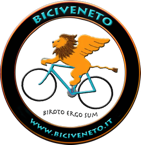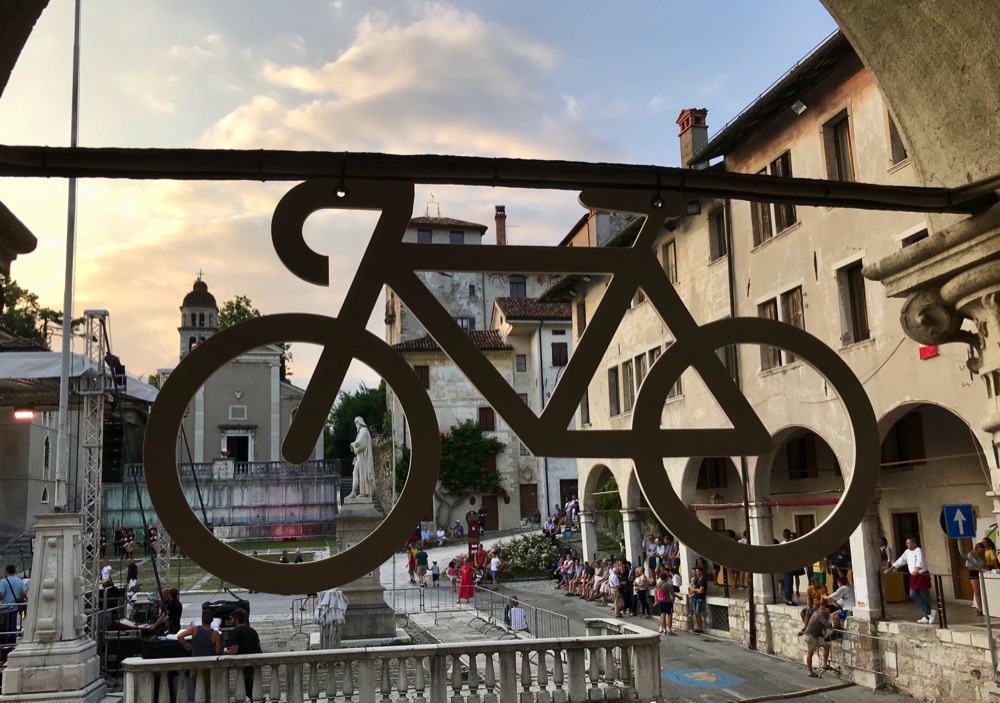
THE CYCLING SCENE
If you are a cyclist riding in the Veneto for the first time on a Sunday morning, you will experience the delightful sensation of having alighted in a world where bicycles rule. You'll encounter hundreds--maybe even thousands--of cyclists of all kinds, from families on organized pedalate ecologiche (ecological rides) to cicloturisti taking part in raduni (rallies), fast sport-riding clubs tackling switchback climbs with gusto, and probably even a race or two. You'll see lone riders, merry groups of friends, clubs in their team uniforms, and even old-timers in wool, astride vintage bikes.
Who's riding all those bicycles you see on the roads of the Veneto? Bikes are part of everyday life, so you'll always find plenty of people using them for transportation to work, school, and shopping, as well as recreation (you don't see many joggers here). As for the "serious" riders, they come in many categories...
Pros
Everyone knows the local pros: they've watched them race since they were kids, followed their progress up the ranks, and ridden with them at one time or another. They have fan clubs organized by proud and adoring neighbors, friends, and family. Some past Veneto riders of note, many of whom are still involved with the sport, include Giovanni Battaglin, Eros Poli, Flavio Vanzella, Bruno Cenghialta, Massimo Ghirotto, Stefano Zanatta, Marzio Bruseghin, Filippo Pozzato, Fabio Baldato, Andrea Ferrigato, Alessandro Ballan, Emanuele Sella, Gianni Faresin, Silvio Martinello, Davide Rebellin, Moreno Argentin, Damiano Cunego, Franco Pellizzoti, Giorgio Furlan, and Matteo Tosatto. (Linguistic note: surnames ending in "n" are typically Veneto). There are many, many more riders whose names are remembered only by the most ardent and knowledgeable fans. Check out the Veneto Pros page to see the current riders from the tri-Veneto (the Veneto and neighboring Friuli and Trentino regions)
U23s
U23s are no longer called dilettanti; they are in fact professional riders. U23 teams are registered as UCI continental teams, and in many cases are development teams for World Tour teams. One of Italy's most renowned and successful U23 teams has its home in Castelfranco Veneto: Zalf Désirée Fior, in more than 40 years, has won over 1100 races and produced 8 world champions, 2 Euro champions, and 30 national champions, including Daniele Pontoni, Cristian Salvato, Kurt Arvesen, Mirko Gualdi, Giuliano Figueras, and Ivan Basso, and continues to send many of its riders (more than 120 over the years) to the pro peloton: Vanzella, Fondriest, Zen, Piccoli, Bertolini, Leoni, G. Zanini, Lanfranchi, Zanolini, Serpellini, Finco, Trenti, Bruseghin, Derganc, Cauz, Quinziato, Faresin, Colli, and Pozzovivo. Giro champion Paolo Savoldelli, Giro stage winner Emmanuele Sella, and Giro champion Damiano Cunego are alumni too. Current riders include Sacha Modolo and Gianluca Brambilla.Their jersey design is that of the old Brooklyn team of Roger De Vlaminck, but the colors are red, white, and green, instead of red, white, and blue. The Colpack/Ballan and Trevgiani teams have also made their mark.
Cicloamatori
These are the true amateur racers: men and women with jobs and families, who race each weekend strictly for the love of it (hence amatori). The racing is, fast, serious, and competitive. Some cicloamatori are ex-pros who missed the sport. This term is often used (by the press, for example) to distinguish a "serious" cyclist, i.e., one wearing a kit, helmet, cycling shoes, etc, from a simple ciclista, which means anyone anyone riding a bike.
Ciclosportivi
are strong, fast, serious, expert recreational riders, especially granfondo riders. There is a specific license for this category.
Cicloturisti
are not touring cyclists with bikepacking bags or panniers on their bikes, but serious and competant, but non-competitive cyclists who like to ride at a more relaxed pace (relatively speaking), have fun, and enjoy the sights and cameraderie. There are even competitions and championships for this group.
Ciclo Ombre
The word ombra means "shadow," but in the Veneto language it has come to mean a nip of one's favorite alcoholic beverage (Prosecco is a favorite). Ciclo ombre are cyclists who head out for a bike ride but spend more time stopping for ombre than they do in the saddle!
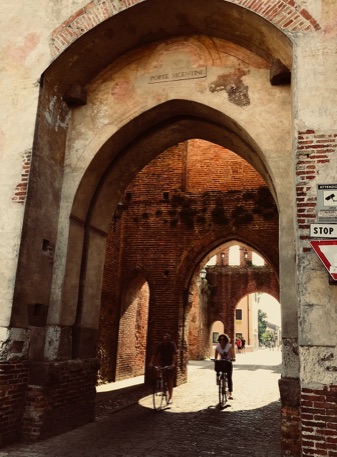
There are approximately 900 cycling clubs in the Veneto region. They range from small, informal groups whose members do their own thing to large, super-organized outfits with their own well-equipped vans for transporting riders and their bikes to events, and acting as support vehicles at large organized rides. They will often charter buses to attend distant events so that family members can come along, go sight-seeing, and share the inevitable post-ride picnic or dinner with their cyclist spouses/parents. Young riders are not lacking in support either--there are clubs which supply them with virtually everything they need (bikes, kits, helmets, warm-ups), organize their physicals, winter preparation, and training rides (accompanied by an adult and/or following vehicle), and transport them to races.
Clubs are sponsored by local businesses both large and small, and by such disparate groups as AVIS (blood donors), railroad workers, hospital personnel, and so on.
CLUBS, FEDERATIONS, and LICENSES
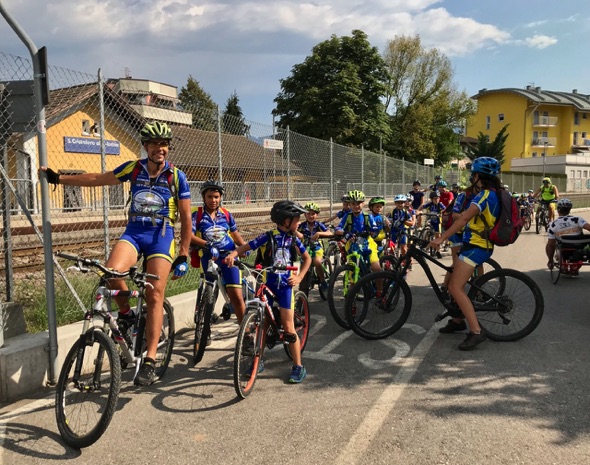
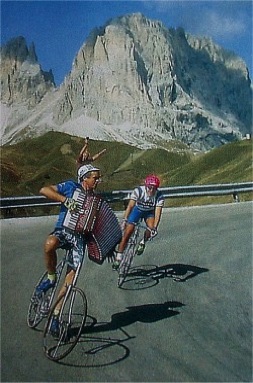
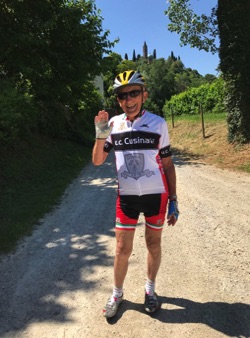
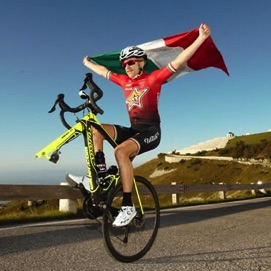
Giuliano Calore, a cyclist who defies categorization. The exploits of this musician and champion of acrobatic cycling from Padua have earned him the title "Cyclist of the Impossible." For example?
• in 1981 he climbed and descended the Stelvio Pass while playing, in turn, four different musical instruments, including an amplified accordion.
• his most famous feat was his 1985 descent of the 48 hairpins of the Stelvio Pass on a bike with no handlebars or brakes! His time was just over 27 min., averaging 80 km/h,
1986 https://www.youtube.com/watch?v=ZV4MJok1_2o
• In 2015 he descended the Stelvio at night! View the trailer of the film.
Visit his site to see more photos, and a list of his 12 Guiness World Records.
LOCAL LEGENDS
Calore on the Sella Pass, with the Sassolungo in the background, The photo is from his website.
Magico Tempe on Monte Grappa, The photo is from his website.
Simone Temperato aka Magico Tempe
The late Ginesio Ballan is known as the man who climbed Monte Grappa two thousand times, in every season of the year and in all kinds of weather. His garage door company was also a sponsor of numberous cycling teams, including Gewiss-Ballan (we actually bought a Ballan garage door because of that!)
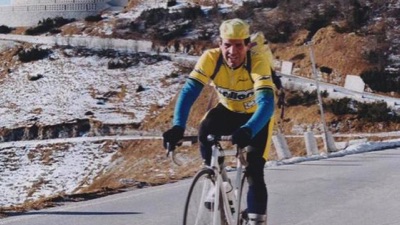
Ginesio Ballan
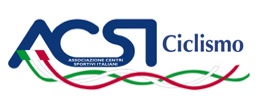
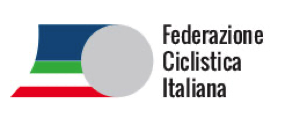
The "official" national federation is the FCI (Federazione Ciclistica Italiana), which issues licenses to, and sanctions events for pros, U23s, ciclosportivi, cicloamatori, cicloturisti, and children of various age groups.
Another important licensing and sanctioning body is the ACSI (Associazione Centri Sportivi Italiani), which is exclusively for cicloamatori and cicloturisti.. Both federations sanction road, TT, cyclo-cross, track, and MTB races, road and MTB granfondos, gravel events, and touring activities such as organized rides, rallys, and competitions. Granfondos and most touring events are open to members of all federations.
An FCI cicloamatore license entitles the bearer to participate in races, granfondos, and touring events. The holder of an FCI ciclosportivo license can ride in granfondo and touring events. As ACSI does not offer a ciclosportivo license, a cicloamatore license is required to ride granfondos. A cicloturista, regardless of federation. can only enter touring events.
Ferruccio Lunardon
Obtaining a license requires a physical exam. Cicloturisti only need to see their regular doctor and get a certificate of good health. Cicloamatori and ciclosportivi need to visit a sports medicine specialist for a more extensive exam, including a stress test.
No license is necessary for doing ciclo ombra rides!
If you are entering a granfondo, you will be able to use the license isued by your country's cycling federation, as long as it's recognized by the UCI. A one-day license is available to those who have none. In either case, a medical certificate is required.
THE VIBE
Here the sport of cycling is respected, esteemed, revered, even venerated--but it's not considered cool. It's just another mainstream sport, with no particular aura or mystique. It's not a cult or a clique, nor does it have an elitist, snobby, or upscale image--on the contrary, it has traditionally been the people's sport, practiced by working class guys, tradesmen, artisans, small town merchants, and farmers, not well-to-do professionals with university degrees. Today's cyclists, of course, may come from any profession and socio-economic group, but the humble and down-to-earth image of the sport remains, and that's just the way everyone likes it. Even most of the pros are regarded as regular, hard- working guys, in contrast to the rich, glamorous stars of sports such as soccer and Formula 1. Pros are down-to-earth and accessible and we ride the same roads they do--even with them, sometimes--so there is a special bond between them and their fans that exists in no other sport.There is a great deal of camaraderie and solidarity among all members of the vast cycling community. Cyclists will always stop to give other cyclists a helping hand (and motorists often will too).
Italians are fond of saying that "cycling is a school for life." One of the first lessons is humility, and here it comes naturally. With so many great riders on our roads, only a fool would have any illusions or pretensions about his own greatness or importance in the cycling scheme of things. Poseurs can't fool anyone for long. Everyone knows how hard the sport is and can appreciate and respect the efforts of other riders, regardless of their riding level, attire, gender, age, physique, or bike. There are no bike fashion police or silly sets of rules concocted by self-proclaimed "purists" who like to think they're in the know and feel superior (such as not wearing pro team jerseys, not carrying a saddle bag, wearing only black shorts and white socks). You'll see plenty of cyclists wearing the jerseys of their favorite teams and others decked out in the latest fashionable kits, but you'll also see overweight old guys with jerseys stretched to the limit, and blown out, droopy lycra shorts, riders wearing outdated, mis-matched pro kits and sneakers, and riding hybrid bikes, folks wearing t-shirts with bib shorts straps over them, and infinite combinations and variations of the above. The fact is, there are simply far too many cyclists for anyone to take particular notice of anyone else, or for anyone to stand out in a crowd. Everyone just rides his own ride, content to enjoy the sport in his or her own way. Italians will certainly admire a beautiful frame with intelligently chosen components (and they will ask questions about, discuss, and even critique your choices), but just having a top-of-the-line famous-brand bike will impress no one. Italians will compliment a cyclist's elegant riding position and graceful pedaling style, or her grinta, determination, and savvy on a climb, regardless of her speed. But forget about impressing anyone with your exploits: there's nothing you can do that hasn't been done--and outdone--many times over. Someone will have climbed the mountain faster, ridden more passes in a day, suffered even more extreme weather conditions, or won harder races...thus, most cyclists here are a modest and unassuming lot...and that includes the pros.
Italian cyclists aren't into projecting an image or broadcasting their membership in the cycling fraternity. This form of "self-expression" is just not part of the Italian character or culture. Besides, no one cares if you're a cyclist anyway-- there are thousands of others, everywhere you look! Therefore you won't see cars displaying cycling-related stickers, folks wearing cycling t-shirts, neckties, or bike chain bracelets, nor using bicycle-shaped pizza cutters, Christmas tree ornaments, or similar gadgets and do-dads, nor sporting Campagnolo tattoos (Italians are more likely to use Shimano or SRAM components, anyway). Cycling is as commonplace as baseball and basketball are in the US. It is not an exotic sport from a faraway land. Campagnolo is just a local manufacturer of bike parts, not cult objects inspiring veneration. That flashy jersey on a passing rider might be advertising nothing more glamorous than a local muffler shop or beauty salon. Romance is in the eye of the beholder.
WOMEN CYCLISTS
Visiting Americans are often surprised to see so few "serious" women riders about. To understand why, we must know a little about the development of cycling here, and to be cognizant of differing cultural concepts of femininity. Until the 60's, Italy was not a wealthy nation, and the Veneto was just another poor region. Bicycles were used primarily for transportation. People worked hard and had neither the energy nor the free time to engage in recreational cycling as we know it today. A Sunday spin with one's family or sweetheart was as far as it went. Of course there were those relatively few hardy and intrepid souls who competed in what was even a more rough, grueling, and gritty sport than it is today: bikes without gears, unpaved roads, and no mechanical or feeding support to speak of. It was certainly not a sport for women (although there was one gutsy female who competed in a long-ago Giro d'Italia). As cycling as a pastime gained popularity, women still did not take to it. It was considered a male-- and decidely unfeminine--sport, and most women just weren't interested in doing it, any more than a typical American woman would want to play tackle football. There were few role models for woman cyclists, and little encouragement or support for them. But the changing of women's roles, and "glamorous" champions such as Alessandra Cappellotto and Paola Pezzo helped make cycling more attractive and acceptable to women. Of course, sexism dies hard, and woman racers are often noted for their attractiveness, or lack of it. I see many more women on the road now, though most are riding mountain bikes, hybrid bikes, and e-bikes, and not tackling long climbs.
DRIVERS & THE PUBLIC
It's understandable that visitors believe that Italian drivers harbor a special affection for cyclists, given their attentiveness and awareness of our presence, and the respect, courtesy, and consideration they accord us (most of the time). In truth though, this behavior can probably be attributed just as much to cultural influences as to affinity for cyclists. From infancy on, children are surrounded by bicyclists of all kinds--they are everywhere. Virtually everyone has ridden a bicycle for transportation, if not for recreation. Therefore, an Italian kid--or more precisely, a Veneto kid--grows up with the attitude that bikes are legitimate vehicles with a right to be on the road. In driving school, which is required for obtaining a license, students are taught not only to be aware of cyclists, but to anticipate possible difficulties they may encounter (a pothole, broken pavement, a big puddle, etc.) and to treat them with care. Drivers are taught to open their car doors with their right hands, automatically putting them in a position to see a passing cyclist. When I took the road portion of my driving exam, three of the six candidates failed--one of them for not showing the proper consideration to a cyclist! As a result, I feel quite safe riding on Italian roads, but many other cyclists do not. Times have changed: our immigrant population has grown and there are more and more drivers from countries lacking the Veneto's cycling tradition and driver training (and who attempt to cheat on the driving test written exam). More insidious threats have arrived in the increased popularity of SUVs, which are simply too large for many of our favorite little back roads, and worst of all, arrogant, self-entitled, self-centered drivers (usually in expesive Audis, Land Rovers, etc) who think that laws are for the weak and powerless. There's also an increasing number of drivers under the influence of alcohol, drugs, or cell phones. Unfortunately, Italy has Europe's highest death rate for pedestrians and cyclists.
A number of my non-cycling friends have complained to me about cyclists taking up the road and failing to move over (and they are right! I get angry with inconsiderate cyclists myself). I've seen drivers irate when they had to wait in a long line for a raduno (rally) to pass, or needed make a detour because a road had been closed for a gran fondo. So cyclists are not universally adored here. However, neither I nor anyone I know has ever been the victim of harassment, assault, violence, or road rage (but it does happen, even to the pros). We have instead, been treated to countless acts of thoughtfulness and kindness. I've been invited into the homes of strangers for a coffee, glass of wine, and even fresh homemade tiramisù! Strangers allowed a desperate friend and me to use their bathroom when we were on an organized ride on an island in the Venetian lagoon, where there were no bushes to be found anywhere. They've stopped to ask us if us were ok or needed help when they saw us standing by the side of the road. When a bee stung my thigh and I went in a bar to ask for ice, the concerned owner insisted on driving me to a pharmacy in the next town so I could buy antihistamine cream.
"...poi Dio creò la bicicletta perchè l'uomo ne facesse strumento di fatica e di esaltazione nell'arduo itinerario della vita. ...essa è diventata monumento all'epopea sportiva della nostra gente che sempre è stata aspra nella virtù, dolce nel sacrificio."
Bruno Raschi
"...then God created the bicycle so that man could make of it an instrument of toil and of exultation on the arduous journey of life...it became a monument to the sporting epic of our people, who have always been strict of virtue, sweet in sacrifice."
In Progress!
